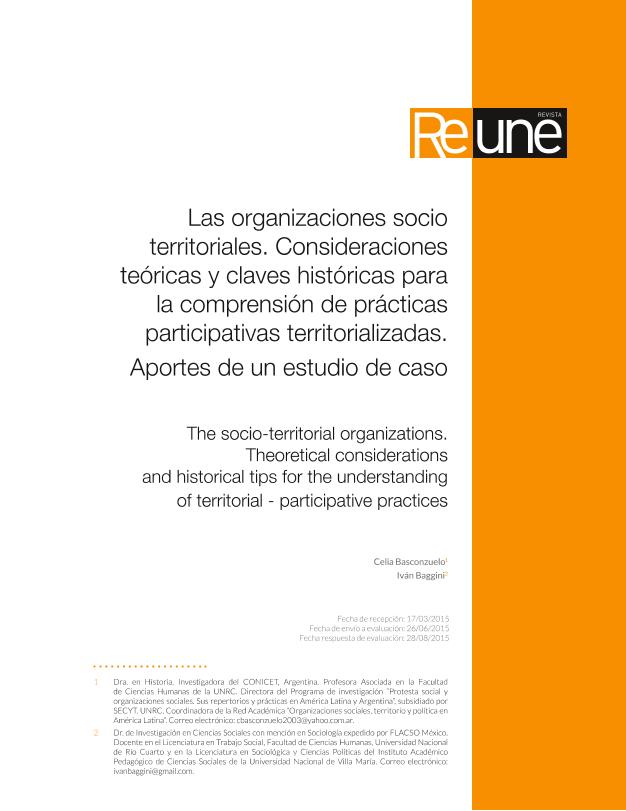Artículo
Las organizaciones de la sociedad civil (OSC) conforman un vasto universo, integrado por entidades que se caracterizan por desarrollar objetivos, prácticas y actores diversos. En este heterogéneo universo, pueden clasificarse las organizaciones sozcio-territoriales (OST), cuyo rasgo de identidad primordial es presentar un anclaje en los territorios de base, siendo parte de la trama suburbana. Uno de estos tipos de organización son las Asociaciones Vecinales (AV). En Argentina, pueden considerarse herederas de la tradición fomentista, cuyo momento fundacional se sitúa entre fines del siglo XIX y comienzos del XX, según la historia de cada ciudad, conforme iban creciendo las barriadas y de acuerdo, sobre todo, a la decisión de los vecinos que se movilizaban en pos de lograr mejoras materiales y culturales para su barrio. El presente artículo responde dos interrogantes centrales de investigación, vinculados a la cuestión de las localizaciones territoriales de las OST: ¿Mediante cuáles prácticas las AV construyeron sus espacios territoriales de acción? ¿Hubo variaciones en ese proceso según los cambios en la relación Estadosociedad y según los regímenes políticos? En razón de lo expresado, el objetivo de este artículo consiste en estudiar las prácticas que las AV desarrollaron desde sus territorios de base, y en el contexto de una escala temporal que atravesó gran parte del siglo XX. The civil society organizations (CSO) compound an extensive universe, integrated by entities that are characterized by developing diverse objectives, practices and actors. In this heterogeneous universe, the socio-territorial organizations (STO) may be classified, whose main identity feature is presenting a mooring in the base territories, being part of the sub-urbane link. One of these types of organizations are the Neighborhood Associations (NA). In Argentina, these may be considered heritages of the foment tradition, whose foundational moment is located between the end of the XIX century and the beginning of XX one, as the history of every city, just as the neighborhoods had made bigger and, specially, the decision of some neighbors who were actives in order to achieve improvements in materials and culture aspects for their neighborhood. This paper answers two central research questions, links to the STO´s territorial localizations: ¿By means of which practices did NA build their action territory spaces? ¿Were there variations in that process as the changes of the State-society relations and the political regimens? Therefore, the paper´s objective is to study the practice that NA developed since the base territories, and in the context of a temporal scale that passed through most of the XX century.
Las organizaciones socio territoriales : consideraciones teóricas y claves históricas para la comprensión de prácticas participativas territorializadas : aportes de un estudio de caso
Título:
The socio-territorial organizations : theoretical considerations and historical tips for the understanding of territorial - participative practices
Fecha de publicación:
11/2015
Editorial:
Institución Universitaria de Envigado
Revista:
Revista Reune
e-ISSN:
2500-4786
Idioma:
Español
Tipo de recurso:
Artículo publicado
Clasificación temática:
Resumen
Palabras clave:
Organizaciones Sociales
,
Territorio
Archivos asociados
Licencia
Identificadores
Colecciones
Articulos(CCT - CORDOBA)
Articulos de CTRO.CIENTIFICO TECNOL.CONICET - CORDOBA
Articulos de CTRO.CIENTIFICO TECNOL.CONICET - CORDOBA
Citación
Basconzuelo, Celia Cristina; Baggini, Iván Gustavo; Las organizaciones socio territoriales : consideraciones teóricas y claves históricas para la comprensión de prácticas participativas territorializadas : aportes de un estudio de caso
; Institución Universitaria de Envigado; Revista Reune; 1; 11-2015; 75-99
Compartir




